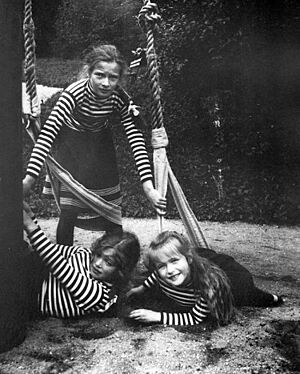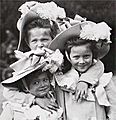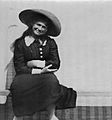Grand Duchess Maria Nikolaevna of Russia (1899–1918) facts for kids
Quick facts for kids Grand Duchess Maria Nikolaevna |
|
|---|---|

Grand Duchess Maria Nikolaevna, around 1914.
|
|
| Burial | Peter and Paul Cathedral, Saint Petersburg, Russian Federation |
| House | House of Holstein-Gottorp-Romanov |
| Father | Nicholas II of Russia |
| Mother | Alexandra Fyodorovna (Alix of Hesse) |
| Religion | Eastern Orthodox |
Grand Duchess Maria Nikolaevna of Russia was a princess from Russia. She was born on June 26, 1899, and passed away on July 17, 1918. Maria was the third daughter of Tsar Nicholas II, who was the emperor of Russia, and his wife, Tsarina Alexandra Fyodorovna.
Maria and her family faced a very difficult time during the Russian Revolution. She was killed along with her family in 1918. Later, the Russian Orthodox Church recognized her and her family as saints, calling them "passion bearers." This means they are honored for their faith and the way they suffered.
Maria was too young to be a Red Cross nurse, unlike her older sisters. Instead, she helped by being a "patroness" for a hospital. She often visited soldiers who were hurt. She cared a lot about the soldiers' lives and enjoyed meeting them. Maria dreamed of getting married and having a large family one day. Even when she was young, people noticed she was quite friendly and outgoing.
For many years, there were rumors that Maria's younger sister, Grand Duchess Anastasia Nikolaevna of Russia, had escaped when the family was killed. However, later studies proved that Anastasia did not escape. All members of the Imperial family died in 1918.
In the 1990s, when the family's burial site was found, it was thought that Maria's remains might be missing. But in 2007, more remains were found. DNA tests confirmed that the entire Imperial family had indeed died in 1918.
Maria's Appearance
People often said Maria was a very pretty and friendly girl. She had a healthy, slightly plump build. Her hair was light brown, and she had big, blue eyes. Her family even joked that her eyes looked like "Marie's saucers" because they were so large.
Her French teacher, Pierre Gilliard, described Maria as tall and strong, with rosy cheeks. Tatiana Botkina, a friend of the family, thought Maria's eyes were "soft and gentle." When she was a baby, some people compared her to an angel in a painting by Sandro Botticelli. Her uncle, Grand Duke Vladimir Alexandrovich of Russia, lovingly called her "The Amiable (Good-hearted) Baby."
Her Life and Childhood
Maria grew up in a simple way, despite being a princess. She shared a room with her sister Anastasia. Their room had gray walls and a ceiling painted with butterflies. The furniture was plain, in white and green colors.
When Maria was very young, she once ran away from her bath and explored the palace without clothes! Her Irish nurse, Margaretta Eagar, was busy talking and didn't even notice. Maria's aunt, Grand Duchess Olga Alexandrovna of Russia, remembered, "Fortunately, I arrived just at that moment, picked her up and carried her back to Miss Eagar."
Maria's older sisters sometimes didn't want her to join their games. They even called her their "stepsister" sometimes. This was because Maria was usually very well-behaved and didn't get into trouble, according to her nurse.
However, even sweet Maria could be a little mischievous sometimes. Once, when she was small, she secretly took some biscuits from her mother's tea table. Her governess and mother wanted to send her to bed as a punishment. But her father, Nicholas, said no. He joked, "I was always afraid (fearful) of the wings growing. I am glad to see she is only a human child."
Maria's nurse, Margaretta Eagar, said that Maria loved her father very much. She often tried to sneak away from the nursery to "go to Papa." When her father was sick with typhoid, Maria would cover a small picture of him with kisses every night.
Images for kids
-
Grand Duchess Maria wearing a kimono-style dressing gown c. 1915.
See Also
 In Spanish: María Nikoláyevna Románova (1899-1918) para niños
In Spanish: María Nikoláyevna Románova (1899-1918) para niños















